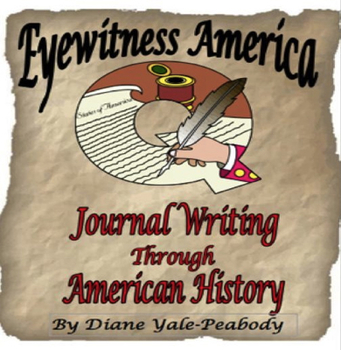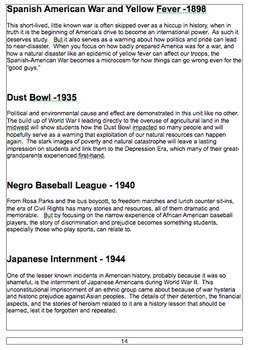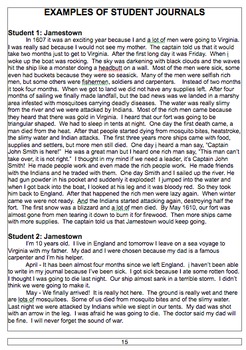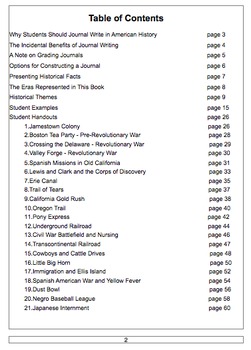Eyewitness America
Diane YalePeabody
92 Followers
Grade Levels
4th - 8th
Subjects
Resource Type
Formats Included
- PDF
Pages
60 pages
Diane YalePeabody
92 Followers
Description
Combine Social Studies with Language Arts in this creative journal-writing unit. With 21 exciting eras in American History covered in my program, I’ll show you how to get students interested in the “I was there” mode of journal writing. I’ll also advise you on the benefits of journaling, how to present information to students, how to grade assignments, and show samples of student writing. This year-long program can be tailored to any grade level from 4th grade through junior high. You will find incidents which have been turning points in history, trends that have become epoch-making, and little known events that text books just don’t cover. Some may include historical events you have had to skip over in class because you just didn’t have time to cover them - eyewitness journal writing can be the way you introduce students to these historical periods without taking up too much class time. Eras covered in my workbook are: Jamestown, the Boston Tea Party, Crossing of the Delaware, Valley Forge, Spanish Missions, Lewis and Clark Expedition, the Erie Canal, the Trail of Tears, the Pony Express, the Underground Railroad, Civil War battlefields, the Transcontinental Railroad, cowboys on cattledrives, the Battle of the Little Bighorn, immigrants and Ellis Island, The Spanish American War and Yellow Fever, the Dust Bowl, the Negro Baseball League, and Japanese internment camps. I’ve included fact sheets on these eras with details about the who, what, where, when, why and how it felt - these are not journal prompts - they are inclusive notes which run one to one and a half pages for each era! I’ve taught this unit of journal writing for many years and also used it as a springboard for creative writing during Young Authors workshops. This 60-page download is formatted as a PDF.
Here’s a sample of what one of the handouts with facts and figures.
ERIE CANAL 1825
Write your journal entry as someone who helped build the canal and you are looking back at those years. Write about
Why and how the canal was built
How big it was and where it was located
Different jobs and pay
Dangers and hardships
What daily life was like including food and shelter
Don’t forget to include details about the sights, sounds, and weather. Use the following notes to add facts to your writing.
Reason for the canal
Settlers/fur trappers/farmers needed easier shipping east for products (apples, flour, wood, pelts) and getting supplies (axes, plow, buttons)
Road journey took a month and crossed Appalachian Mountains
Canal avoided snags and rocks in rivers, flood waters that could sweep boats off the river, low water which could strand boats
The Big Ditch
40 feet wide, 4 feet deep, 363 miles - longest uninterrupted canal in the world
From Albany on the Hudson River to Buffalo on Lake Erie
Climbed 565 miles in elevation
18 aqueducts, 83 locks (built of cut stone blocks and waterproof cement)
Tow path 10 feet wide
Promoted by governor of NY - DeWitt Clinton
Took 8 years to build - 1817-1825
Workers
Mostly Irish
2000-3000 men
Jobs - stake setters, soil borers, underbrush grubbers, tree fellers, stump pullers, root cutters, ditch diggers and dirt movers
Wages - grubber - 50¢ a day and found (food and lodging); carpenter or ax man - $1 a day (compare to farm work - 35¢ a day)
Camp Life
Rising horn blows at sunup for 14-hour day
Breakfast - sausage, steak, eggs, ham, pork chops, baked or boiled potatoes, corn bread, white bread, cakes, molasses, flapjacks, fried mush, milk, buttermilk, coffee, tea
Lunch - meal packed in a quart pail
Dinner - same as breakfast plus bear, venison, duck, partridge, fish, turtle, mutton, squirrels, rabbits, cabbage, onions, turnips, squash, peas, pie
Slept in a shack that holds 24 men on wooden bunk beds - bring your own woolen blankets and cornshuck mattresses or cut hemlock branches
Sunday was a day off
Malaria
Montezuma Marshes in western New York - mosquitoes from May until frost
1/3 of workers in bed with “canal shakes” or “ague” - chattering teeth, muttering in delirium
Hundreds died
2 kinds of mosquitoes - one during the day did not carry disease but bit so ferociously that men returned to camp with eyes almost swollen shut and hands unable to hold tools. Other kind of mosquito awake at night - carried malaria
Smudge pots with smokey fires burned constantly to keep mosquitoes away but caused the workers to cough constantly and burned their eyes and noses
Men afraid of catching malaria deserted the canal and didn’t return until fall - all work on the canal stopped
Other hardships
Marshes - jungles of 6-foot reeds, quicksand, and mud
Flood waters from rivers could wash out a stretch of canal that had just been dug
Leeches attacked men standing in knee-deep water
Sunburn from working shirtless in the heat
Dynamiting to get through rocky stretches or to build the locks - accidental explosions killed men
End of the canal
Completed with the ‘marrying of the waters” - governor poured a barrel of Lake Erie water into New York Harbor with cannons booming and bands playing Yankee Doodle
Canals twice as fast as overland trail and about 15 times cheaper
Canal replaced by trains which could take more passengers and were quicker
Eyewitness America by Diane Yale-Peabody is licensed under a Creative Commons Attribution-NonCommercial 3.0 Unported License.
Here’s a sample of what one of the handouts with facts and figures.
ERIE CANAL 1825
Write your journal entry as someone who helped build the canal and you are looking back at those years. Write about
Why and how the canal was built
How big it was and where it was located
Different jobs and pay
Dangers and hardships
What daily life was like including food and shelter
Don’t forget to include details about the sights, sounds, and weather. Use the following notes to add facts to your writing.
Reason for the canal
Settlers/fur trappers/farmers needed easier shipping east for products (apples, flour, wood, pelts) and getting supplies (axes, plow, buttons)
Road journey took a month and crossed Appalachian Mountains
Canal avoided snags and rocks in rivers, flood waters that could sweep boats off the river, low water which could strand boats
The Big Ditch
40 feet wide, 4 feet deep, 363 miles - longest uninterrupted canal in the world
From Albany on the Hudson River to Buffalo on Lake Erie
Climbed 565 miles in elevation
18 aqueducts, 83 locks (built of cut stone blocks and waterproof cement)
Tow path 10 feet wide
Promoted by governor of NY - DeWitt Clinton
Took 8 years to build - 1817-1825
Workers
Mostly Irish
2000-3000 men
Jobs - stake setters, soil borers, underbrush grubbers, tree fellers, stump pullers, root cutters, ditch diggers and dirt movers
Wages - grubber - 50¢ a day and found (food and lodging); carpenter or ax man - $1 a day (compare to farm work - 35¢ a day)
Camp Life
Rising horn blows at sunup for 14-hour day
Breakfast - sausage, steak, eggs, ham, pork chops, baked or boiled potatoes, corn bread, white bread, cakes, molasses, flapjacks, fried mush, milk, buttermilk, coffee, tea
Lunch - meal packed in a quart pail
Dinner - same as breakfast plus bear, venison, duck, partridge, fish, turtle, mutton, squirrels, rabbits, cabbage, onions, turnips, squash, peas, pie
Slept in a shack that holds 24 men on wooden bunk beds - bring your own woolen blankets and cornshuck mattresses or cut hemlock branches
Sunday was a day off
Malaria
Montezuma Marshes in western New York - mosquitoes from May until frost
1/3 of workers in bed with “canal shakes” or “ague” - chattering teeth, muttering in delirium
Hundreds died
2 kinds of mosquitoes - one during the day did not carry disease but bit so ferociously that men returned to camp with eyes almost swollen shut and hands unable to hold tools. Other kind of mosquito awake at night - carried malaria
Smudge pots with smokey fires burned constantly to keep mosquitoes away but caused the workers to cough constantly and burned their eyes and noses
Men afraid of catching malaria deserted the canal and didn’t return until fall - all work on the canal stopped
Other hardships
Marshes - jungles of 6-foot reeds, quicksand, and mud
Flood waters from rivers could wash out a stretch of canal that had just been dug
Leeches attacked men standing in knee-deep water
Sunburn from working shirtless in the heat
Dynamiting to get through rocky stretches or to build the locks - accidental explosions killed men
End of the canal
Completed with the ‘marrying of the waters” - governor poured a barrel of Lake Erie water into New York Harbor with cannons booming and bands playing Yankee Doodle
Canals twice as fast as overland trail and about 15 times cheaper
Canal replaced by trains which could take more passengers and were quicker
Eyewitness America by Diane Yale-Peabody is licensed under a Creative Commons Attribution-NonCommercial 3.0 Unported License.
Total Pages
60 pages
Answer Key
N/A
Teaching Duration
Lifelong tool
Report this resource to TPT
Reported resources will be reviewed by our team. Report this resource to let us know if this resource violates TPT’s content guidelines.





